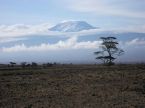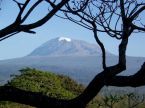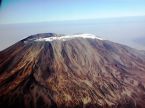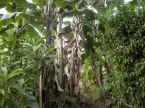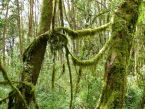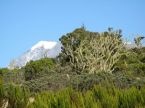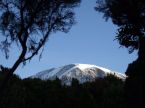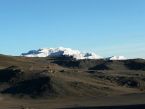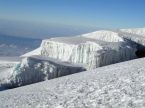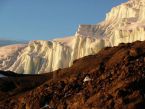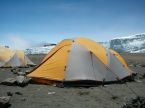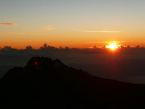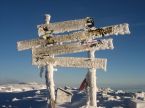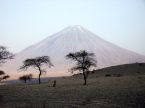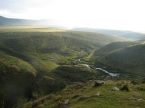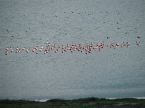



Treks
The Kilimanjaro
Kilimanjaro represents the whole splendor of East Africa. It is not only the highest peak in Africa, it is also the highest mountain in the world standing on this way, in the middle of the savanna.
The Kilimanjaro National Park covers an area of 755 sq. km. It is located 130 km from Arusha.
Reaching the summit of Kilimanjaro is not too difficult for such an altitude. Many walkers have already reached the edge of the crater, Stella Point, just before the true summit, Uhuru Peak.
There are several paths that bring you to the top and the climb is normally done in 6-7 days / 5-6 nights.
We are specialized in the Machamer route (in refuge), which requires experienced guides and best logistics, but we also offer the Marangu (in refuge) and Shira (in camp) routes. Thanks to the quality of our from Europe imported equipment and to the professionalism of our teams, we provide a very high success rate (over 80%).
To improve security, we optionally provide a decompression chamber and we use mobile phones to be in permanent contact with our teams. We work with french and english speaking guides, and our cooks compete to offer our guests a balanced and varied menu, prepared only with fresh products.
Necessary equipment:
- A quality sleeping bag (-15° C to -25°C),
- A sewn linen,
- Polar jacket, shirts, T-shirts,
- Warm high mountain shoes (-22°C)
- Warm wool socks, tights, cotton socks, underwear in goretex,
- Wool hat, sun hat, gloves,
- Pullovers, sweaters, hot pants, tights in goretex or equivalent (do not hesitate as it is cold !),
- Sunglasses, sun cream,
- A rain coat,
- A field bottle or a camel bag of 2L,
- A pocket knife,
- A flash- or better a frontlight with spare batteries and bulb (especially for ascents at night)
- Belt or bag for money and papers (always on you),
- Toilet bag, towel,
- Telescopic walking sticks,
- Pharmacy handbag (medecine against pain, eye drops, vitamin C, care for the feet, anti-mosquito, anti-diarrhea, intestinal antiseptic, wide-spectrum antibiotic, pills again altitude sickness...etc),
- Micropure tablets to purify water,
- Toilet paper,
- Dried fruits, energy bars...etc
Provided equipment
3 people tents and mattresses.
All kitchen equipment, tables, chairs, mess tent for meals, expedition food with fresh local produce. Hot meals morning, noon and night.
Safety
The Kilimanjaro expedition is leaded by a trained and specialized local team. We can provide a decompression chamber on demand.
Breathing
As soon as you feel difficulty to breath, stop, rest for a moment, wait for your heart beats getting normal and you can then continue. Do breaks and take the opportunity to admire the landscape.
If it is more severe (begin of headache, nausea, extreme fatigue and loss of appetite), go back or stay where you are. In all cases, your guide is here to help you. Feel free to tell the smallest problem.
Especially do not fear to go back or stop, adjust your breathing and your steps instead of wanting to follow other better trained or fitter climbers. Drink plenty of fluids (3.5 L of water per day) and especially walk at your own pace. This is the guarantee of the success of your climb.
Our guides, porters and assistants are specially trained to look after you and react to any suspect sign, let them trust and listen to their advice.
Do not attempt to go beyond your strength if they ask you to rest for a moment. They are experienced and know exactly how to react in case of problems.
Photography, video
It is better to bring photographic film material from the UK and it will be furthermore not possible to recharge the batteries of a digital camera. You can purchase films in Arusha and Nairobi, but not necessarily of good quality (200 ASA for the summit of Kili in the early morning, 50 or 100 ASA elsewhere). Take a bag to protect your equipment against dust, a pair of binoculars, spare batteries.
For videos and camcorders, bring spare batteries.
Oldonyo Lengai
The only active volcano in Tanzania, the Oldonyo Lengai, is the sacred mountain of the Maasai people. It is located north east of Ngorongoro Crater and south of Lake Natron.
The Ol Doinyo Lengai is the sole volcano in the world to produce a lava consisting of sodium carbonate, iron and calcium, giving a black color when it is molten and white when it cools, which explains the snowy aspect of the volcano.
The volcano last erupted in September 2007 and currently undertaking the ascent of Lengai should be done with caution because the volcano is constantly active.
The climb is done at night in 5 to 7 hours walking in order to reach the summit at sunrise and enjoy a view on the Rift Valley. The area, accessible after long hours on a trail and only inhabited by Maasai, is absolutely beautiful.
The climb is steep and for experienced walkers. It is generally integrated in a safari tour.
Mont Meru
Climbing Mount Meru (4565 m) will be a wonderful experience for all very good walkers. The mountain is near the city of Arusha.
The ascent is quite steep and needs three or four days, with accommodation in refuges. It includes several climbs and descents with a very steep final section. Technically, Mount Meru is the most difficult trek in the region, but it is an excellent preparation for the ascent of the roof of Africa, the Kilimanjaro.
Splendid views on Kilimanjaro and Lengai will reward you for your efforts.
Olmoti and Empakaai craters
Not far from the Ngorongoro crater are 2 other craters, less known and less visited than the previous one, but still interesting for a day of hiking off the beaten pathes.
Olmoti crater, from which the river Munger with its beautiful waterfall rises, culminates at 3290 m. On beautiful walks you will admire spectacular views. It will also be an opportunity to meet Maasai and their cattle near the village of Nainokanoka.
The Empakaai crater, partially filled by an alkaline lake, appears as an oasis. The steep trail that descends into the lush jungle is absolutely fantastic. Below, thousands of pink flamingos have find their home.
From Ngorongoro to Natron
We can also organize a trek of 3 days/2 nights from Ngorongoro to Natron, via the Empakaai Crater. Naiobi ans Acacia. A local Maasai guide will escort you, as well as some donkeys to carry your luggages and all the camping equipment. A beautiful hike through the Rift Valley.
